The US Vintage Grand Prix
Neil’s recap of the US Vintage Grand Prix in Watkins Glen, New York.
Tuesday, September 4th. Today begins the long haul back to Central New York’s Syracuse area. Looking forward to my 3rd trip to the SVRA’s US Vintage Grand Prix at Watkins Glen on the shores of Seneca Lake, part of the beautiful Finger Lakes region, I’ll make my way through Hancock Field, the local Syracuse airport, near Liverpool, my adolescent home. Lou Bottega, my high school and college friend will pick me up, spirit me to the home of Bill Branson, another high school buddy and race driver extraordinaire. Bill and racing partner Bob Will make up Secret Racing Motorsports, multi year participants in the SVRA Grand Prix. I’ll spend the night at Bill’s house prior to Wednesday’s early morning departure for Watkins Glen, New York and race week.
My participation in photography at this prestigious vintage auto racing spectacle happened quite by accident. August, 2009 brought about my 40 year Liverpool High School reunion. One day while at work in May, 2009 I received a telephone call from Lou Bottega asking me if I planned to attend. Quite surprised since I hadn’t spoken with Lou in more than 30 years, I responded in the negative.
Thinking about it a little more, I attempted contacting Bill to see if he resided in the area and planned attendance at the reunion. Sure enough, Bill still lived in the area though he had no plans for meeting up with anyone from Liverpool High’s Class of ’69. After a brief reminiscence, we agreed to get together and plans took shape. Bill later sent me an e-mail containing a photo of him driving a race car at the 2008 SVRA Grand Prix. Since, as kids, we traveled through the earliest of morning and latest of night hours to watch races at ”The Glen,” I knew Bill had a deep interest in cars. This, however, was way over the top. Reunion anticipation began taking second place to excitement about Bill and his racing.
After all the reunion festivities, Lou Bottega, my wife Shielia and I made our way to Bill’s house. We didn’t have a lot of time since our Salt Lake bound flight left Syracuse the next day. None the less, it was great to see Bill after 35 years’ time. Nice home, great family. His love of all things motorized showed in his car shop. Even though we needed to head back to Lou’s house for packing and flight preps. I just had to see the race cars and learn all about this exciting activity.
I was completely unprepared for the image greeting me when we walked into Bill’s garage. Before me sat a 1960 Alfa Romeo Giulietta Spyder, a 1969 Porsche 911 2.2 and Formula Ford cars, an Elden and a Winkelman Palliser, all race ready. Unbelievable! Descriptions, experiences, stories harrowing and humorous ensued. I described my snowmobiling adventures and photography as if to try to measure up in some way to Bill living his race car driving dream. I couldn’t come close but the idea of me coming to the 2010 US Vintage Grand Prix precipitated from discourse and the idea took shape. I created a 2011 calendar for the small cadre making up Secret Racing Team.
Aside from a biblical deluge during set up and registration day and the track closing due to fog on Friday morning, the 2011 Vintage Grand Prix proceeded without a hitch. 2011′s race season drew to a close with the calendar publication. Our crew expanded to include Rocco Cannata of Can Tech performance car services in Syracuse, NY, and Andrew Northrup, Bills son.
Now SVRA US vintage Grand Prix week becomes an annual event, each year attempting to exceed extremes of the year before. The crew includes one more newby (to me, at least,), Bruce Northrup, Andrew’s older brother. 2012 promises no change from our history.
So, tonight, its reunion, dinner, talk and great Finger Lakes wine in anticipation of heading to The Glen tomorrow morning. Good times to be had by all, once we wake up.
Wednesday, September 5th. Last night’s rain brought back memories of the many humid sticky days making up summers of my youth. Walking around Tuesday night in remnants of Hurricane Isaac, downpours interspersed with light drizzle. I remembered why I decided to move to Salt Lake City’s arid climate. The night air hung on me like a wet towel. Weather could not, however, diminish excitement mounting for the following morning and trip to Watkins Glen International Raceway.
6:00 AM and we climbed aboard his spotless mammoth tractor trailer combination bearing 3 race cars and his “Mule” utility vehicle. Central New York’s glacially sculpted terrain, currently lush and green following summer’s week after week of unusually hot and dry days, stretched to the horizon. Taking Route 20 through red brick constructed towns of Auburn and Seneca Falls then south through Finger Lakes wine country, we finally laid eyes on Seneca Lake, making our way down its eastern flank arriving at Watkins Glen. A sleepy small town residing at Seneca Lake’s southernmost shore, one would never know one of the world’s premier racing facilities sits atop neighboring rolling hill farmland dotted with red barns, cow herds, fields of flowers and acre upon acre of maple trees. NASCAR, Sprint Cup and Formula races earning world class importance take pace here every year. SVRA’s US Vintage Grand Prix brought us here for my love of race car photography and Bill’s love driving of all things fast. First, though, we had to park the truck & trailer.
I accompanied Bill and Lou Bottega to The Glen for the last 2 years’ SVRA Grand Prix weeks. I mentioned excitement and anticipation generated by this event. Only watching Bill maneuver nearly 80 feet of Freightliner tractor and United Trailer car hauler generates more energy. Over the years Bill picked out a certain parking spot in The Glen’s Paddock parking. Requiring a large turning circle in a nearly empty Paddock (hence the reason for a 6:00 AM departure from Skaneateles…don’t want to fight the other rigs for turning and parking space) and a smooth transition into our spot next to the mid Paddock entrance facilitates a smooth exit at Grand Prix week’s end. Just a little backing and squaring up usually does the trick. Not this time.
Entering the Paddock anticipating a repeat of previous years’ arrival regimen, we discovered The Glen placed a small self contained snack vending booth in the place where Bill normally lodges his truck and trailer. We weren’t quite sure what to do. Nervously moving about, inquiring of track staff regarding options to move the booth yielded no alternatives. They were too busy ushering through the tank column stream of race car hauling rigs, rushing them to their Paddock parking places. We decided to simply park alongside the offending dumpster sized obstruction, making use of our new found extra parking space. Now our team and visiting guest vehicles easily moved in an out of our compound during the day since we occupied 2 parking spots instead of one. We needed to make sure we had room for the 40 foot tent Wilson’s would shortly arrive to erect. Lou arrives Friday with his feast in a box trailer and SUV combo. We need plenty of space for that. All in all, considering the light first day turnout of racers and support staff, we felt we had it under control. Settling in and spreading out, we considered it all good.
Next comes the ballet like coordination of unloading the vehicles. A marvel of efficiency, the trailer holds 4 cars, 2 on each of 2 levels. The internal elevator makes moving the cars a breeze. First undo the tie downs. No fun trying to untangle a mass of steel, tires and fiberglass, fastening cars in place is essential. Everything has a place. wood ramps, steel ramps, human power and engine power unloads the Mile ATV/People Hauler, 2 Formula Fords and a Porsche 2.2 in about 30 minutes. While we unloaded the cars, Wilson’s team arrived and erected our huge circus tent. Its amazing The Glen allows drilling holes in their parking lot. Images of the The Circus coming to town conjure their way into your mind as the Wilson’s workers pound 1 inch diameter steel stakes into holes drilled at each corner.
Rolling our 4 vehicles under the tent, Bill now directs his attention to completing paperwork required to get the cars on the track. Racing at a previous SVRA event in June, the Formula Fords and Porsche earned an annual Tech Pass meaning they needn’t undergo Tech Inspection at the beginning of each race event. Second to none, Rocco Cannata’s Syracuse based CanTech race car preparation assures Bill and Bob not only a fast ride but a safe one as well. Drivers must submit their passed Tech Inspection certificates to track officials in order to obtain required stickers admitting them to the track. Drivers must also fill out medical forms for use in case of emergencies while racing. Considering race incurred injury possibilities, minimizing response and care time might prove invaluable. Track officials must anticipate all necessary safety and care when drivers’ lives might be on the line.
Bill and I waited for Bob’s arrival later in the afternoon. Bob’s family saw US Vintage Grand Prix race week as a great chance to visit relatives near LA. No Dad, no need to stay home. Bill wanted to take the Porsche out for a test run with other drivers wanting to check out mid season repairs and improvement to their vehicles prior to warm up and race sessions coming up later in the week. Since Bob experienced a little off roading during the June SVRA Classic Enduro event, Rocco had to replace some shocks and related components making up the car’s suspension system. In addition Rocco worked some magic on the engine and shifting mechanisms making the car a completely different machine. Bill told me they bought the car from a retired dentist, listening to its previous owner list off all improvements and mechanical adjustments done to make the car competitive. Once Rocco got into the car, though, it seems some of those improvements didn’t improve much. 5 laps on test day, today, showed the car had a lot of zip left untapped until CanTech let it out. Bill said the car behaved like a completely different machine.
SVRA offered drivers some welcome Wednesday afternoon practice time to check fixtures, nuts, bolts, tires instruments and more. After attending the SVRA’s required driver’s meeting conducted by Competition Director Ray Snowdon and Event Director Jon McKnight for explanations regarding safety and procedures during the practice, Bill prepped to take the Porsche to the track.
For me its back to the truck for my camera gear and a walk. At last. My time arrives! Shooting pictures the rest of the day. Heaven. Back at the trailer I assembled my gear. D200 for the 24-70 f2.8 Nikkor zoom. Even the cranky old D200 would sing with Nikon’s best lens on it. Pixels Foto was kind enough to let me try the Nikon 1 V1. We had these in stock for a while and, since I like to make sure I know our inventory inside and out, Ray allowed me to bring this marvel of technology to The Glen. Since it has capability of shooting stills at up to 10 frames or more per second, video at up to 1200 frames per second, HD video at 720 60P and 1080 30i, as well as continuous AF shooting about 5 frames per second at full sensor resolution, I thought it would make a great addition to the arsenal of stuff required to carry around the track. Lightweight and easy to carry, its a Nikon, assuring great results. Sling the V1′s strap over my head and add it to the list. Now comes the most divinely inspired piece of photo equipment ever created. Nikon’s D700. All photographers know they need to suffer for their art. Race photography is no different than landscape, portrait, macro or any other shooting. You have to bring stuff. Perhaps landscape photography compares with the amount of walking involved but I doubt other photographic endeavors measure up. I earlier mentioned The Glen’s sinuous 3.4 mile track. To get to the best shooting spots on the track you walk. And walk. And walk. You walk around the outside of the track, through tunnels to the middle then around the inner diameter. I usually bolt the 80-400 ED Nikkor zoom on the D700. A lens with an undeserved reputation for mediocre optical quality, the 80-400 marries a useful zoom range with tolerable portability. Between the body and lens, a shooter ports about 4-5 pounds. It doesn’t sound like much but you may know the amount of photographic weight carried actually increases in direct proportion to the amount of time carried. I think an engineer could write a formula describing the phenomenon. One must also consider age factors increasing the slope of this curve along the time axis. If I want to do pan shots I use the D200 with the 24-70. I like the 24-70 on the D700 but I need to make sure I have a position close enough to the subject. If more reach fills the bill, the 80-400 on the D200′s APSC 1.5 crop factor sensor creates a greater telephoto feel. Stepping to the side of The Watkins Glen International Raceway’s track half way up “The Esses,” along side turn 3 about 11:00 AM I start shooting. I instantly feel inadequate. Did I set my focus mode correctly? Continuous focusing required. Set focus points to 911 central with assist points. If my fast moving subjects leave my main focus point, immediately surrounding points take over with the intent of keeping the subject sharp. Shoot in Continuous High, 5 frames per second. I feel the need to keep the shooting rate down, though. Creating hundreds of extra images by simply holding down the shutter release might increase probabilities for success but it also creates hundreds of images requiring review. I decided to shoot “Moment of Truth,” more than “Spray and Pray.” If the situation calls for multiple shots rather than a single shot at the exact moment, then I’ll lay on the release.
I double check all the settings for white balance, ISO and shutter speed. The 80-400 provides best reults at f8. Its noticeably sharper than 5.6 or 11. I learned this during the 2010 Vintage Grand Prix weekend. The D700 features capability for maintaining a minimum shutter speed by self adjusting ISO in Auto ISO mode. I haven’t used this feature yet. Different car groups consist of cars racing at different speeds. I think its quicker to check shutter speed manually as each group starts on their pace lap than to go into Auto Shutter Speed Maintenance.
One of my favorite shots results when waiting for my subject vehicle to nearly fill the frame then taking the shot. These cars are FAST! I have a very small fraction of a second to grab the shot. Practice, practice, practice. I feel very rusty. My timing is off. I also need to remember where I must place my main focus point. Do I center it? If its incorrect, I risk taking the shot too early causing poor composition. I will often “lead” the subject meaning I move the focus point to the right or left of center so I keep the subject where I want it for what I feel will make better composition especially in open wheeled vehicles. If I’m shooting an open wheeled car such as a Formula V, Formula Ford, Indy Lite, F1 or other version I get a clear view of the driver. Looking for the up close and personal shot, I’ll concentrate on images showing the front wheel, driver and engine in a straight line. Its also a good shot when including the entire car. With closed cabin vehicles such as Ford GT40′s, Porsches in all their iterations, MGB-GT’s, the lone Panoz, all the Corvette Coupes, Mustangs and so on, images showing drivers either from the side of the vehicle or looking through the windshield offer a bit of insight portraying driver intensity.
Addition of the Nikon V1 required a little experimentation. I trained myself on the product before leaving Salt Lake City. Even though I played with all the features, there’s only so much you can do without being in a true to life shooting situation. I was very interested in shooting video at 400 FPS as well as 60 and 30 FPS in HD. The V1 has a 10 FPS and faster still photo mode. I wanted to try that as well. It took me only a few attempts with the 10 FPS system to decide it was not for me. Most of my shooting requires moving focus points to appropriate places within the viewfinder. I couldn’t make that work. The subject tracking mode wouldn’t track fast moving cars. I opted for setting the mechanical shutter in continuous shooting mode for about 5 FPS while employing Aperture Preferred. As with the vast majority of my shooting environments, Aperture Priority offers the greatest degree of shutter speed flexibility over the widest variety of shooting situations.
The 400 FPS mode is extremely cool. It just requires a little practice and visualizing what actually happens. At 400 FPS, the camera allows a 5 second or 4 GB limit. Just keep in mind, 400 FPS for 5 seconds results in 2000 frames. Played back at 30 FPS, you must now endure 67 seconds of slow motion video. Take my word for it, that’s way too long.
I found grabbing a second or 2 of video works pretty well. Timing the start and stop of the shutter as close as possible to the arrival and departure of your subject in the viewfinder helps avoid seconds of worthless video. Blank no action portions of scenes showing only grass, trees or track surface in slow motion create boredom beyond description. You must also make sure scene composition is correct so your slow motion shows the portion of the subject you want. I created and deleted many scenes of roll bars in slo mo, lower portions of tires and even scenes where I missed my subject entirely. A 5 second duration scene works well.
While I’m shooting, the rest of Bill and Bob’s afternoon passed with adjustments, preparations, paperwork and anticipation. Bob’s dedication and love of the sport and its related equipment showed as he admired the new paint job on his Winkelman/Palliser Formula Ford. A little rub here, a little polish there and the car was ready.
Returning from my spots on the track following test runs, we all agreed to head down to Watkins Glen village and our hotel anticipating dinner at the restaurant next door to the Harbor Hotel and retirement for the evening. Descending from my 4th floor room to meet Bob and Bill in the lobby, the elevator picks up another passenger on 3. The gentleman says with a slight German accent, “You must be a race car driver.” While I’m deciding what could possibly make this man say something like this, I think, “Is it my rakish good looks, my slim athletic physique, my air of confidence, my jet fighter pilot attitude?” No. I told him I was here to do photography of the race. He revealed, “Oh. I just saw the white line around the back of your neck from the lanyard.” Shoot down! A great evening of race talk, old memories and rekindled friendship followed. Recognition of an early start to Thursday forced the end of the day. Bed time and welcome sleep. Hello beautiful Harbor Hotel. Good night!
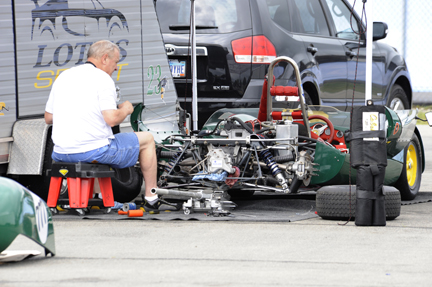
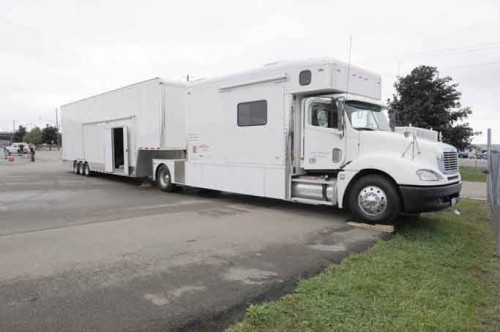
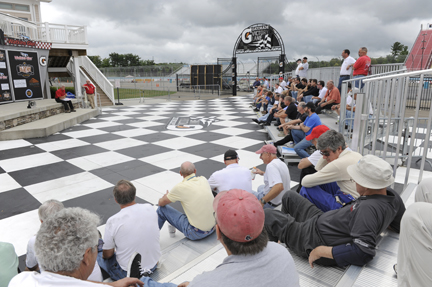
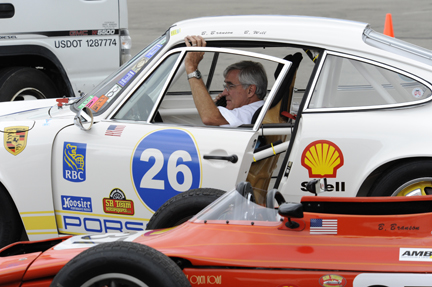
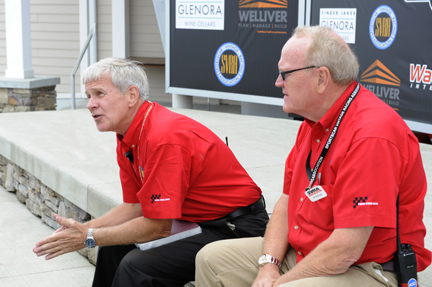
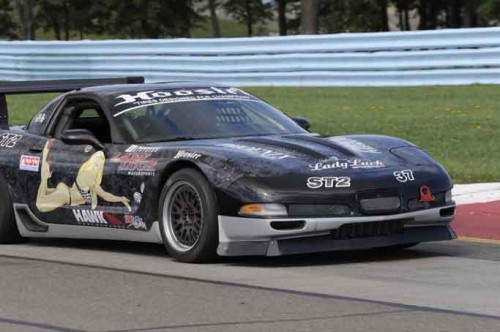
Thursday, September 6th. An early breakfast at the Harbor Hotel’s great restaurant begins the day. We make our way back to Bills truck in the WGI Paddock. Qualification begins in earnest today. Before I begin shooting, Bob needs to get back in the saddle. Bill ran the Porsche yesterday. Bob decided to take it out on the track for a test run this morning. I could sense excitement and angst. Bob hadn’t been back in the car since it spun off the track in June. Lining up on the grid his attention narrowed to getting out on the line around Watkins Glen’s sinuous track through the Finger Lakes forest. No time for sight seeing. Bob had only the road filling his vision. Lap 1, Bob hung in with the other drivers. Laps 2-5 showed him dropping back a bit. The car performed, after all, as a new ride. Made it. Smiles all around. Now to shooting.
I wandered back over to turn 3 on “The Esses.” More roaring up the track. After a night’s worth of time remembering how to shoot, how to hold the camera and lens, perfecting use of focusing points the images start to come in. Fewer misses and more hits result in more keepers. I recalled another technique I like o use. In order to add more energy to the image, I like to tilt my camera a few degrees left and right. The moving car subject looks faster with greater intensity. Working with any camera, you can render your subject in different ways, matching the emotional tone you wish to create.
I wanted to take some time to work on my panning technique. You no doubt tried this with people on bicycles, maybe a skater at the skateboard park or even someone on a motorcycle, ATV or snowmobile. You slow your shutter speed, checking ISO and aperture to assure proper exposure. The trick is determining correct shutter speed for your subject. Faster subjects require use of faster “slow” shutter speeds. In fact using a shutter “too slow” for your subject make good pans nearly impossible. Slower shutter speeds allow shooters to not only pan the camera at an incorrect horizontal speed, but inadvertently move the camera vertically as well causing blur. Shooters must also determine which body panning motion follows the subject’s motion most precisely. Starting low at the pan’s beginning point but ending rotation on a higher plane or completing the motion in the opposite manner, results in vertical blur. I start by squaring my shoulders to my subject. I believe chances of getting a good pan increase if your body is square to the subject when releasing the shutter. If your body twists all the way to the left or right at shutter release you have a tendency to lower the camera at the end of the turn resulting in unwanted vertical motion. Do a couple of practice swings with your subject. Acquire the subject making sure your focus point, in continuous focus mode, is on the vehicle at a a great distance. Follow it in while partially depressing the shutter release. Your camera should focus all the way in. As the subject closes in on you start determining the point at which you want to finish pushing the shutter release all the way down. In most cases the image looks best when the subject is closest to you. If its a moving car, shoot when the vehicle is directly opposite and parallel to your position. I watch subject size to make sure I don’t cut off the front or rear of the car. I have plenty of images when these parts are missing so prepare to make lots of errors. A car too small in the image fails to take advantage of the sensor’s maximum resolution so keep it big in the viewfinder.
The D200 with the 24-70 worked pretty well for panning. My Press Pass for WGI gets me close enough to reach out and touch drivers in many cases. This means the Nikkor’s SWD motor easily keeps up with focus commands received from the D200 body. The D200′s 1.5X crop factor gives me some additional flexibility for adjusting field of view. Sometimes I go for the up close and personal view of the driver with a pan shot. This can become a bit challenging when attempting a field of view this small. Plan to take a lot of pictures! You’ll miss a bunch before you get that one great shot.
After time at turn 3, I wander over to the outside of Turn 11. Another good track location, you see cars pointing in the “opposite” direction than. Adding good variety to your collection of racing images, I shoot like Turn 11 from the “outside” of the track rather than from the “inside” of the track as on Turn 3. 11 is also a great spot for good close ups of cars and drivers. Cars coming through Turn 10 drift to their right, accelerating toward Turn 11. Closing on Turn 11 drivers drift to their left trying to lengthen the curve radius. As they slow to make the turn shooting both pans and incoming still shots becomes a little easier.
Shooting this race for the past 2 years, I feel like I know the track pretty well. Before arriving at WGI I tried to think of places I haven’t shot or, at least, haven’t shot very much, I decided to try a couple of new spots. Looking at a relatively new portion of the track called “The Boot,” I felt a possible location for some new looks might be Corner Worker Station 13 on The Boot’s “Heel,” on Turn 8, Corner Worker Station 12 and in Turn 7 lying at “The Toe” of the boot. 1st stop upon departure from Turn 11 is Flag Station 13. My D700 and 80-400 lead off. While the shots were pretty easy they weren’t what I hoped for. Good detail and sharpness. No Pizazz. On to Flag Station 12. Checking in with Bob Holcomb, experienced flag man, I set up shop. Same thing. I try a few pan shots. No zip to the shots again. The track’s sharpest turn with easy photo access is Turn 7. Cars brake coming into Turn 7, accelerating out so they’re not at full speed. Shots come a little easier. Drivers bunch up as they round the corner, occasionally providing a good shot of several cars lined up in the turn. This is a good one. I’d come back here. The Nikon V1 video looks good. Pans and stills work out well.
I shot a couple of events at Miller Motorsports Park in Tooele, Utah. That’s the desert. You have to deal with wind and heat. Seldom must you deal with rain. This is Watkins Glen, New York. I somewhere heard Central New York receives more rain in a year than the commonly accepted Rain Kingdom of Seattle. I don’t know if this rumor is true but it seemed so this weekend. Watching the sky while at Turn 7, the heavens took on an angry look. Billowing dark gray clouds piled up over the thick green of the forest. I stood about as far away from the truck in the paddock as I could get. I figured I should head back. At least I might make one of the pedestrian tunnels before rain began falling. By Flag Station 12, first drops landed on the top of my D700 as well as the hood of the 80-400. Swinging my gaze to the south west, rain diffused detail of the forest on the horizon. This wasn’t good. I was 300-400 yards from the pedestrian tunnel. In only a few seconds, the rain hit rate on to op the camera skyrocketed. I stepped up to the corner Bob’s Flag Station asking if I could share space under the station roof. He invited me up the several steps to his work area explaining how wind could easily blow rain under the roof and across the entirety of the station’s 8X10 foot area. “We’ll see what happens,” he offered. No sooner had the words left his lips, the sky unzipped and down it came. He asked if I parked close by. I replied I came from the Paddock. He pointed to his car and said, “Come on up here. You’ll never make it.” We sat in his car where I learned he lived in Liverpool very close to where I grew up. He worked in and retired from Wegman’s grocery store, the back of which I could see from my former home. Small world. He and his wife flag at race tracks up and down the east coast from The Glen to Baltimore to Homestead, Florida.
Rain pounded down for about 15 minutes, backing off long enough to quickly make my way to Turn 11. Half walking/running through light rainfall with my camera protected under my Port Authority Official AT&T Wireless raincoat, I thought about image possibilities resulting from rain accumulation on the track. The WGI Media Center displayed a very cool image of Vintage drivers launching tall water plumes off their tires in rain far heavier than this. Would I be that lucky? Would I have to take my camera out in actual rain conditions to shoot an image like that? Would they hold up racing until they dried the track? Do they dry the track?
Finally landing back at Turn 11 I saw a few drivers on the track. I’m not a race car driver. I never will be. I wondered what it must be like to drive fast in the rain. How does it feel when your tires break loose? Do you have any warning? How wet do you get in an open cockpit car? How do you see with no wiper on your helmet visor? What happens when approaching another car from behind? Is it the mother of all showers? The first group of cars were enclosed cabin vehicles. With wipers wiping they seemed to have the situation under control. A small patch of water lay about 2/3 the way between Turns 10 and 11. As each driver blasted through it, water sprayed aloft. Not quite s cool at the photo in the media center but good enough to show flying spray. Car after car passed. Water exploded from under tires less and less. It looked like my opportunity evaporated. Then it began to rain again. I headed for the Pedestrian tunnel only 30 or so yards from the Flag Station on Turn 11. Joining me were a small family with a young boy about 2 years of age as well as a few others waiting out the shower. Lasting about 15 minutes or so, the shower lifted long enough for me to get back up trackside. Only occasional bursts of rain flew overhead. When intensity grew, I dropped in on the Flag Worker, taking a few shots through his chain link fence protective barrier. The 80-400 at 400mm dissolved away the fence wire so shooting through it posed no problem. ISO had to climb to 1600 + because the sky remained death gray. The track took a brief break as groups changed. Who’s group came up next? Group 2, Bob and Bills Formula Fords.
Engines roared in the distance over Paddock and Starting Grid as the Formula Fords left for Turn 1. Moments later they screamed up the back straight toward The Bus Stop chicane and the 140 foot descent leading to The Boot containing Turns 6 and 7. Next came the uphill climb out of The Boot past my absolute favorite shooting spot on the track on Turn 9. Toward me they came around 10 and the leader was Bob Will! OMG! Slightly less aggressive in his approach, Bob cruised past me as the D700 snapped several pictures. Bill must be close behind. The next drivers, however were not Bill. He was nowhere in sight. Next lap, Bob still has the lead but no Bill. Bob actually wins this heat.
By this race’s end, 5:00 PM and the end to the day’s racing arrives. We decided to eat dinner at Seneca Lodge, an antique watering hole attracting racers since the 1940′s. Rocco and I drove to our rooms at the Harbor Hotel, dropped off gear, cleaned up and prepped for the trip back up the hill, past the entrance to Watkins Glen State Park and on to Seneca Lodge. While waiting for Rocco, I spent a few extra minutes downloading images as well as dropping batteries into their appropriate chargers. Reconnecting in the lobby we make the trip up the hill to meet up with the rest of our group, Bob, Bill, Bill’s 2 sons, Andrew and Bruce Northrup who arrived earlier that afternoon. The place was packed as we expected. Stepping up to the bar I picked up my drink to nurse for the rest of the evening. We gave our name to the dining room manager, learning we had one hour and 20 minutes to wait. We passed the time talking about racing, family, history and about everything else we could think of. Our 80 minute wait came and went, still no call. Exasperated with the wait and no assurance of a table in sight, we departed, hopping into our cars meeting at our hotel’s restaurant. It was way too late to eat by this time but that didn’t stop us. Too much food. Too much to drink. Time for bed.
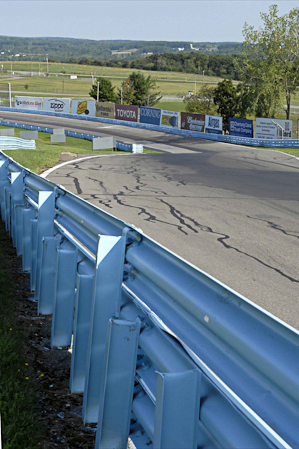
Friday, September 7th. Friday morning started slightly later than previous mornings this week. Since we had a few extra minutes, I ventured outside to find the village and lake shore enshrouded in fog. A little disconcerting since the Friday of 2011 race week lost several hours of track time to fog, I called up the hill to Bill. He said it was bright and clear track side. Since there’s always time for photography, I brought out the Nikon V1 and ran off some shots around the lake shore and harbor. Yes, humidity from early in the week remained, but it added some nice atmosphere to the area.
Rocco and I arrived at the truck approximately 9:30 AM, late as racing start times go. By this time Louie Bottega arrived with his Feast in a Box trailer. Eric Will, Bob’s dad arrived with Rocco’s 13 year old son, Young Rocco and Eric’s friend Avery Sinclair. The tent area was getting a little busy though we planned for it. Louie brought enough food for 25 even though most of the time most of the time our small team consisted of Bob Will, Bill Branson, Andrew and Bruce Northrup, Rocco, Young Rocco, Lou and me. Lou’s friend and business partner, Tommy Potter, parked his new red Ferrari California coupe under our tent. Paul Schubmel parked his new Mazda Miata out front. While mild in comparison to the paddock’s Aston Martins, Cobra originals, Cobra replicas, Jaguars, Porsches of all descriptions, Fiskars and nearly every other exotic car you could think of, we felt our car collection attracted quite a few auto enthusiasts.
I started my day out at “The Esses,” Turn 3 again. Its the most convenient to our truck. I usually start my shooting just north of Flag Station 4. Starting today no differently from any other day, I fired up all 3 cameras from this position. D700 with the 80-400 worked great. ISO 400 or 800 at F8 no problem. The D200 with the 24-70 performed well. While currently sunny, shooting under overcast skies always presses the D200 to its noise limits. I can shoot ISO 400 without too much problem. ISO 800 exhibits noise at, what I feel, a nearly unacceptable level. I often looked at the entrance to Turn 2 wondering if it would be a good place to get some up close and personals. Since this location lies inside the track, drivers pass by at a nearly constant radius distance from my shooting position. Focus distance and tracking becomes less of an issue. Since sunshine blanketed the track for one of the few times during the entire weekend, the D200 could shoot at ISO 200 with the 24-70 at f4 or f8 at a high enough shutter speed to negate the short camera to subject distance. After an hour or so closer to the Corner Worker station, I slowly made my way down to the inside of Turn 2. In previous years I shot from the side of the track opposite where I now stood. That location worked out pretty well. Pixels Foto displays a 24 X 36 inch print of Travis Engen’s Audi R8 world beater car on one of our classroom doors. Shot from this opposite location, the print always gets a lot of compliments. D700 with 80-400 Nikkor zoom at work for you. Now the lowly D200 gets it chance from inside the corner. 10 megapixels used to rate as pretty high resolution. Today no manufacturers offer a DSLR with sensor that small. None the less with bright sun and the 24-70 Nikkor, I expect great results. It doesn’t disappoint.
While waiting in the registration line Wednesday morning, I renewed my acquaintance with Jon McKnight, SVRA’s Director of Events. Jon introduced me to Tony Parella, scheduled to take over ownership of SVRA beginning Monday morning, September 10th, the day following conclusion of the SVRA Vintage Grand Prix. I took a moment to look up Tony’s car number since his group ran during the time I wanted to shoot from inside Turn 2. Sure enough, I could get a glimpse of Tony’s visage from his open faced helmet as he passed. 5 frames per second on multiple focus points. This focus method works best if you let the camera acquire the subject from a fair distance down the track. This way the AF system in continuous has time to lock onto the subject and track it to the composition you wish to shoot. Nikon’s little green “Focus Ball” residing in the lower left corner ofthe viewfinder shows focus activity as the subject approaches. The little arrows astride the ball light up as AF decides which way to rotate the SWD motor. I could feel the minuscule vibrations as the lens tracked. My first shots ar right on. This is good! After a few drivers, including Tony, pose for their images (not really) I notice image perspectives look a little odd. Finding perspective provided at distance by the 80-400 more pleasing, perspective shown by the 24-70 elongates passing race cars making them look somewhat distorted. While not all bad, I decide to zoom the lens out to 70mm from the position at which I was shooting. This flattened out perspectives a bit. It worked but, overall, I determined inside Turn 2 fell short of my expectations. Tony’s group of Corvettes and other muscle cars concluded their run sending race activity into the mid day lunch break. Its time to walk back to the truck for some of Lou’s gourmet quality lunch, image downloading and battery switching. Racing began at 1:00 PM so I had a little over an hour to reload and reposition. Strangely, after removing the SD card from Nikon’s V1, I found the camera unable to accept the card again. I checked and double checked card position and orientation. No luck. The V1 was done for the weekend. No more slo mo or fun shooting with the 30 -100 zoom.
Following lunch, laughter and libation, I strapped on the D700 and D200, aiming for my all time favorite shooting position at Turn 9. Today this spot generated a lot of business to WGI Track Rescue Services. While none of the mishaps injured anyone, several non ambulatory cars resulted from mechanical issues during spin outs. Approaching Flag Worker Station 14 from downhill and the Pedestrian Tunnel I spotted a dead Datsun 510 on the right side of the track, resting on the grass. It appeared the dead Datsun landed there during previous racing group runs. Rescue had it surrounded and marked while Flag Station workers displayed a yellow flag indicating caution. Turn 9 presents several issues. It sits at the top of a hill. Drivers accelerate toward Turn 9 upon exiting “The Boot,” at its heel. They want to rocket up the hill but the track breaks left at “The NASCAR Straight.” In essence Turn 9 is a blind corner because it lies on the flat hilltop while the hill shoulder obscures the view. The dead Datsun lay in plain view since it quit short of the hill top. Rescue hauled it away just before the next group of heavies began their run. Only about a lap or two into Group 7b a red Lola #298 spun out close to the center of Turn 9 attempting to pass the #11 Hawk Corvette. No oncoming driver could see the red low profile car sitting dead on the track, its left front tire next to the fence and the car sitting at a 45 degree angle to tracks left edge. The next lap’s crush of speeding steel and type A personalities began their acceleration out of Turn 8 and up the hill. Corner workers frantically waved their yellow flag with accompanying hand gestures urging oncoming vehicles toward the track’s right side. Lots of rapid deceleration occurred when they broke over the hilltop. No close calls but angst permeated the corner. Rescue came to the spin out for driver examination and dead vehicle haul away. The red Lola’s group completed their race. Now comes the very high energy Group 9 cars consisting of Formula 1, Indy Lights, Formula 5000′s, Formula 2′s, Formula Continentals and Formula 3′s.
I felt I had the very best spot from which to do photography. I stand at track side with footing slightly lower than track surface. Since race cars come up the hill turning hard left at its apex, my favorite angle, car turning gripping the track with all gravity allows, driver leaning left into the turn, very low shooting position relative to track level, my most action filled images result from this turn. I relish capturing my “Three Quarter” shot, front right tire, driver and engine in line for open vehicles or front right tire and driver behind the windshield in line for enclosed cabin vehicles. Lot of great shots from this spot. Next group starts immediately.
Group 9′s go through their pace lap. Since they conduct pace laps at low speeds this makes for easy shooting practice. Anticipation builds as these road rockets follow the WGI pace car through to Grandstand Straightaway. The Pace Car peels off to pit row and, easily audible from my position on the track, engine whine screams over the trees. I know next time I see them drop out of Turn 8, they will be all business. Relative quiet descends over the track as the hills absorb engines noise with the group dropping into Turn 2. From my turn 9 shooting position my back faces the downhill descent out of The Bus Stop chicane closing out the back straight. I see them through the thinned forest as they blast down the hill slowing imperceptibly on Turn 6′s approach hurtling themselves into The Boot. Through 7 they charge then 8 and up the hill they come. Gleaming white with beautiful graphics, the Group 9 Boraxo labeled Lola 332C car spins out, another victim of Turn 9. It screeches through a rubber bleeding to a stop on track’s left side, facing 180 degrees the wrong way, head on into the rest of Group 9. Out come frenetically waving yellow flags again. More hand gestures grab driver attention urging them to brake right. I to grabbed a couple of shots showing Boraxo’s frightening predicament. Rescue arrives back on Turn 9 again. No injury, just more slow down. Not the way I wanted to end a race, there’s always tomorrow, or not….
This group rounded out the day featuring another spectacle of man, metal and motion. I need to run back to the truck for our Secret Racing Team award ceremony. Arriving at the truck all visitors from earlier in the day gone, we’re back to Rocco, Young Rocco, Bill, Bob, the Northrup Boys and me.
Bill and Bob received an invitation to run in “The Reenactment”, SVRA’s annual Race Week recreation of the original race course through the Finger lakes countryside around Watkins Glen. They ran the Porsche 2.2. After waiting in the starting lineup while interacting with members of the car enthusiast public, meeting and greeting many Watkins Glen residents, event participants and visiting fans, Bill and Bob described car preparations, told racing stories, showed off car features and more. Eventually the tour start came and off they thundered to the delight of all. Completing the course at what seemed like breakneck speeds far too fast for prevailing conditions and bidding farewell to the onlookers, they headed for the Paddock and Bill’s truck. Following our teams first annual recognition awards, ( none of which carry any meaning outside our group,) we broke up for the evening but not before discussing Saturday’s driving schedule and met up plans. Since a majority of team members carried iPhones we decided to view weather forecasts. Not good. All weather forecast resources predicted rain for Saturday. Not good. We decided on a 7:00 AM phone call for race time decision making. Since Bob and Bill stayed in their truck’s “living room,” they served as our track side eyes and ears. Weather conditions vary greatly between the village’s lake side location and the track’s greater altitude south and west of town. Sheer exhaustion forced sleep on Saturday but not without my last thoughts containing a sense of foreboding.
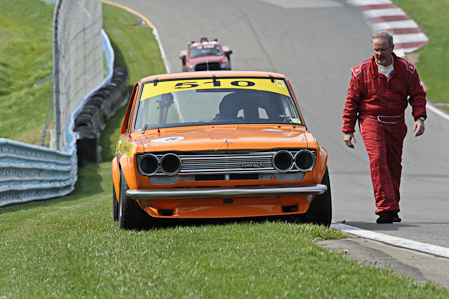
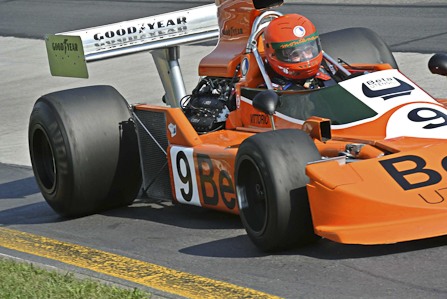
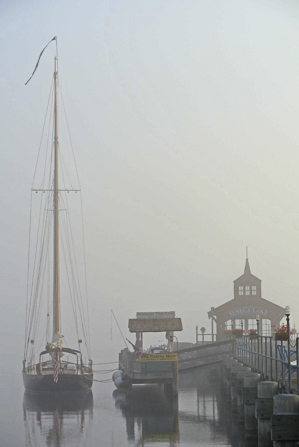
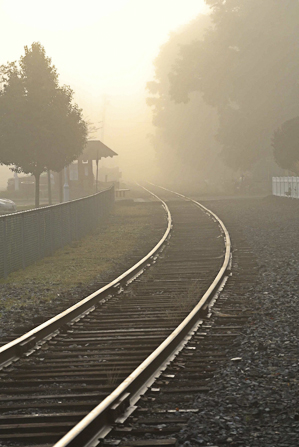
Saturday , September 8th. Saturday’s early morning sky lightened but not very much. Saturday’s forecast on Tuesday showed clear and 74 degrees, a welcome change from the weeks early days of stifling humidity and heat experienced on my arrival in Syracuse. Feeling as though I was trying to breathe through a wet athletic sock, I told Bill the early part of the week’s weather reinforced all the more my feeling a move to Salt Lake City made a lot of sense. 50 percent humidity in Salt Lake seemed overpowering. 95% humidity in New York felt asphyxiating.
After only a day, I felt I experienced enough mid July weather, especially for September. Saturday’s forecast for Saturday, predicted thunder showers, broad based rain and strong wind. Prevailing conditions viewed from our hotel window showed the weather guessers guessed correctly. Wind tortured the trees on our hotel grounds. Whipping branches and tearing off a few leaves, hard charging gusts blew low flying clouds over head, ramming them into hills surrounding Watkins Glen. I made a call to bill at the track. From atop the hills, Bill said it didn’t look too promising. Clarifying forecast wind descriptions from “Strong,” to “70 miles per hour with potential tornado activity,” put a completely different spin on things. PA announcements repeatedly warned us of impending doom. “Make sure you use your heads,” they pounded into us. “We have nasty weather coming our way.” “Make the right decisions.”
Bill and Bob decided to drive at least their Formula Ford group at about 8:00 AM or so. Bill told me wind made cars difficult to control. They agreed, however, they came to The Glen to drive and drive they would. Andrew, Bruce, Bill and Bob helped Lou start packing up the feast in a box trailer. I went over to The Esses to shoot. I figured The Esses were close enough I could run back to the truck for shelter should heavy weather arrive. Earlier in the year I led a photo trip to Monument Valley on the Utah Arizona border. Also enduring high winds, we watched clouds dance overhead providing a spectacular light show not unlike that in the movie Close Encounters of the Third Kind. Light shafts and cloud formations made for great photos. Here at The Glen, gaps of sun among the heavy clouds came and went on the track. High wind shooting seemed to plague my photo excursions for the year. This made shooting very difficult. At one cloud breaking moment, shutter speeds jumped from 1/500th or so to over 1/2000 as the sun pierced through. A moment later speeds dropped to 1/400 as the clouds regained their grip. Keeping ISO matched for f8 performance on my 80-400 presented a challenge once again. I thought about using my D700′s auto shutter speed ISO combination to keep speeds in line. As before, different groups featuring different cars at different speeds made that feature less attractive. Manual operation was the only choice.
The formula Ford group squeezed in their five laps, calling it a morning. Surprisingly, the next group, Group 1, made it out to the track. Thinking this my last chance to shoot for the weekend, I bolted for Turn 11. Everyone else worked hard to put away the gear around our parking site.
A very open part of the track, I knew light would be good there. Since drivers brake for the Turn, I figured shutter speeds wouldn’t be a problem. I was right. My subjects didn’t disappoint. Consisting of Pre War autos, MG’s and MG “T” series vehicles, this group represents a fascinating chunk of history. An established greater part of daily life, cars integrated with society. Not satisfied with simple day to day transportation, engineers and enthusiasts decided fast cars were better than slow cars, nimble cars better than slothful cars. Members of this group resulted, setting the stage for performance cars of today. Peter Giddings’ Alfa Tipo BP3 became one of my favorite Alfas over the last 3 SVRA Grand Prix’s. A stunningly beautiful race car sounding like a throaty V8 from today, it takes muscle and determination to race this vehicle around the track. I watched Peter working hard as the Alfa seemed to require constant love, squealing tires and a firm hand around any turn at which I shot. Here at Watkins Glen gorgeous metal such as this Alfa makes itself at home, fitting naturally into history and the landscape. Other examples of , as described by SVRA, “racing art,” were Bob Fairbanks’ Back Marker Racing Austin Cooper, Bill Stelcher’s 1929 Model A Speedster, Doug Schultz’s Allard K2 and many others.
From a photographer’s standpoint light held up well throughout Group 1′s 5 laps. MG Midgets, MGA’s, Fiats, Alfa’s and others competed fiercely for their place at the finish line. The sky lowered. 9:20 AM launched Groups 3 & 4 around the track. I saw many MGB’s. I wondered how these car owners could keep them on the track. I acquired my MGB, a ’66 model purchased in ’69. It was my very 1st car. I doubted my copy could make a complete WGI track circuit without something breaking or falling off. I called it my $50 per week car. Weekly repairs cost about $50, a lot of money in ’69. The sky lowered some more. Wind began howling. Drivers didn’t care. They saw only the checkered flag in their minds. Get there first. A few raindrops wet my lens hood. OK, my D700 and lenses are supposed to be weather resistant. How does that actually work? I asked myself during trips to the Utah desert, “Does Nikon’s seal really keep out dust, dirt and moisture? Is it just marketing hype? How far do I push it. If I push it too far, how much will it cost to fix? Is it worth it?” Here they come again, frame and shoot. Who’s in front? I spoke with a Group 4 driver on Friday afternoon regarding his car. I thought it a Cobra. It turns out it was a Lister. I never heard of Lister. Tom Malloy did a masterful job powering his car around the track. The Lister’s styling made it fit in with more contemporary cars. Few more rain drops. Track and Corner Workers signal drivers to acknowledge lap five, the final lap. Drivers signal back waving to their signal callers. Some wave, some give thumbs up, some keep their acknowledgment to themselves. When the signal comes, head for the pits.
While Group 5 lined up on the grid ready to make their start, more rain fell. Thinking I stood too far from Bill’s truck and rain shelter, I contemplated heading back. Group 5, though, consisted of some of my favorite cars. World Sports Car Championship and Manufacturers Championship GT’s such as James Cullen’s Ford GT40, Bill Thumel and Tom Shelton’s Lolas, and, most of all Greg Galdi’s Porsche 917K. I decided to tough it out. The rain wasn’t that bad but it looked like it would get worse pretty fast. More photos of the world’s great cars made it worth the risk. I worked pans as well as nose on shots. This is heaven.
Rain stopped for a bit. It seemed the weather Gods intended me to get some extra shots of more world class cars. Next up came HGP F1, Formula 1′s. Rocco Cannata mentioned I should pay particular attention to Chris Mac Allister. Driving a Ferrari 312 T2, this historic car bore the name Niki Lauda on its driver cowling. Rocco described how, back in 1976, Niki Lauda, locked in a battle for F1′s 1976 driving title with James Hunt, experienced a fiery crash in Germany during an F1 race. Other drivers came to Niki’s rescue as he lay trapped in his burning Ferrari. Had they not intervened, Niki would surely have burned to death. Severely injured, Niki worked hard to gain back his health and driving career, going on to compete in the final F1 race of 1976, the Japanese Grand Prix. Described in Wikipedia as a day much like Friday and Saturday at Watkins Glen, wet track conditions caused Lauda to withdraw from the race even though he knew he’d lose the title. Rival James Hunt struggled through several challenges earning him to win. It turns out Ron Howard plans release of a new movie entitled “Rush,” depicting this car and story in September, 2013. No more images for me, though. The deluge released itself. HGP’s left the track. I headed back to the truck.
Arriving at our site, everything packed an loaded for return to Syracuse, there were a few moments of lighter rain among the torrents. One more opportunity for a few rain images. Group 8 drivers, ensconced in their coupes, took to the track in the down pour. Around the track went the Porsche 911′s, 914′s, Datsun 240Z’s, Alfa GTV’s. Fearing camera death from water and predicted tornado activity, our entire group buttoned up the truck and trailer making our way down the hill to Watkins Glen village. Spending the afternoon working hard on Jerlando’s Pizza and this project, we passed the afternoon in safety. Rain pounded down. The track temporarily closed. No tornadoes hit Watkins Glen but did hit the New York City area. Time for dinner and camaraderie.
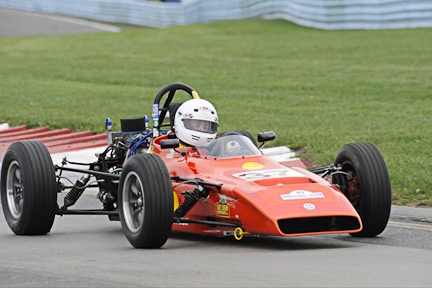
Sunday, September 9th. Looking a great deal like Saturday afternoon, Sunday morning dawned with far less rain but no promise of a dry track. Bill and Bob contemplated unpacking the truck and getting cars out on the track. It would have been a lot of work only to place their vehicles on a potentially wet track. They decided against it and went over to the McDonald’s Family Grandstand to watch drivers willing to brave iffy conditions. Lou and I decided to head back to Syracuse, but first a few more shots with the D200 and Nikkor 10.5mm fisheye as well as a little souvenir shopping. Leaving was a tough decision for me since there was shooting available. I felt I hadn’t helped Lou with his feast in a box. Reluctantly, off we went up the west side of Seneca Lake to Lou’s cabin on Skaneateles. The further we drove toward, Geneva, NY, the more sun we saw. I think The Glen is cursed. Three US Vintage Grand Prix races with rain, fog and clouds at each one. Similar to Oregon and California wine country, we passed winery after winery. Stopping for breakfast at a Versailles Castle like resort known as Geneva on the Lake with beautiful grounds, lovely lake side location and scrumptious food we dined in what seemed a world class facility. Maybe leaving early wasn’t so bad after all. I ran down the manicured garden back slope to the lake hoping for some good images. Absolutely charming boathouse and lounge chairs awaited. Too bad we hadn’t more time. Have to move on. Wending our way across Finger Lakes’ north shores through Geneva, Waterloo, Seneca Falls, Auburn then on through Skaneateles and south to Lou’s lakeside cabin, we found a stunning afternoon of cooler temperatures, clear skies, moderate wind and no humidity. Unloading the truck and trailer, I opened up my laptop hoping to gain some ground on this report. Sunday evening took us back to Bill’s home where we reminisced about the previous week’s adventures. Bill’s wife, Laurie prepared a great dinner for us all. Just as race week began the previous Tuesday, full of excitement and anticipation, we ended it in the same vein, excitement and anticipation for 2013.
This entry was posted on Thursday, September 27th, 2012 at 9:47 am. It is filed under Events, Slider, Uncategorized.
You can follow any responses to this entry through the RSS 2.0 feed.